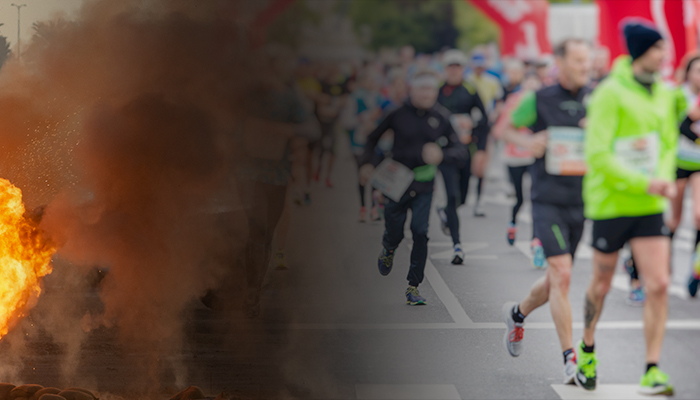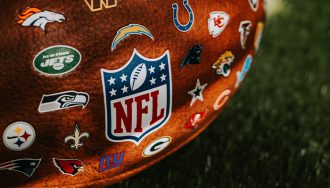Seven of the Most Famous Sports Tragedies

- Sports Tragedies
- Worst Sports Tragedies
- Hillsborough
- Munich Olympics Massacre
- Zambian Soccer Team Plane Crash
- Marshall University Plane Crash
- NASCAR Crash at Daytona International Speedway
- Superga Air Disaster
- Boston Bombing
- Frequently Asked Questions
In today’s post, we look at some of the biggest ever disasters in sports. From shocking accidents to acts of terror, we explore the devastating moments that shook not only the sporting community, but also the entire world. We’ll look at how these disasters happened, and what the aftermath looked like.
Sports Tragedies
This blog takes a closer look at the biggest sports disasters that forever changed the lives of athletes, their families, and fans alike. Thankfully, today, the sporting world is generally safer than ever before, but it’s good to be aware of the potential risks and remember those who perished in the past.
But before we start, if you’re looking to place bets on soccer, check out our guide to betting on live soccer games.
Worst Sports Tragedies
Some of the worst sports tragedies in history often involve the loss of numerous lives, leaving deep emotional scars on families, friends, and entire nations. As we explore these tragedies, it’s crucial to remember the legacies of those who died and consider the lessons we can learn to ensure the safety and security of athletes in the future – something that sporting bodies and authorities have been doing intensely, ever since.
Hillsborough
The Hillsborough disaster stands as one of the most tragic events in the history of sports. It occurred on April 15, 1989, during an FA Cup semi-final match between Liverpool and Nottingham Forest at Hillsborough Stadium in Sheffield, England. That fateful day, an estimated 24,000 Liverpool fans made their way to the stadium, but a lack of proper crowd control and organization led to a horrifying human crush in the standing-room-only terraces.
As fans flooded into the central pens of the Leppings Lane end, they found themselves trapped, with no escape from the mounting pressure. Panic set in as people struggled to breathe, and the situation rapidly deteriorated. When the crush finally subsided, 96 Liverpool fans had lost their lives, with hundreds more injured.
The disaster had far-reaching consequences, leading to the Taylor Report, which recommended the removal of standing-room-only terraces in favor of all-seater stadiums. This report significantly influenced the design and management of sports venues worldwide.
Munich Olympics Massacre
The Munich Olympics Massacre of 1972 is a stark reminder of the vulnerability of sports events to acts of terror. On September 5, 1972, during the Summer Olympics in Munich, West Germany, the Palestinian terrorist group Black September took 11 members of the Israeli Olympic team hostage, demanding the release of 234 prisoners held in Israeli jails.
The terrorists infiltrated the Olympic Village by scaling a fence, armed with automatic weapons and grenades. Over the course of the following day, a tense standoff ensued, and the hostages were eventually transported to Fürstenfeldbruck airbase.
A botched rescue attempt by German authorities resulted in a firefight, leading to the brutal murder of all 11 Israeli athletes and coaches, along with one German police officer.
The massacre led to a profound reevaluation of security at international sporting events. Organizers began prioritizing the safety of athletes and spectators, implementing more robust measures to prevent future attacks – measures which can still be seen today.
Zambian Soccer Team Plane Crash
The Zambian national soccer team experienced an unimaginable tragedy on April 27, 1993, when their plane, a DHC-5 Buffalo, crashed into the Atlantic Ocean just off the coast of Gabon. The team was enroute to Senegal for a World Cup qualifier match, but they never made it to their destination. It’s widely regarded as being one of the biggest tragedies in sports.
The crash claimed the lives of all 30 passengers on board, including 18 players, coaching staff, and crew members. A subsequent investigation determined that the plane’s left engine had failed due to a mechanical fault, and the pilots inadvertently shut down the remaining working engine, causing the aircraft to plummet into the ocean.
The disaster deeply impacted Zambia and the global soccer community, as the country lost a generation of talented players.
Marshall University Plane Crash
The Marshall University plane crash on November 14, 1970, remains one of the deadliest sports-related disasters in American history. Southern Airways Flight 932, a chartered DC-9, was carrying the Marshall University football team, coaching staff, and a group of supporters back to Huntington, West Virginia, after a game against East Carolina University in North Carolina.
Tragically, the aircraft crashed just short of the runway in poor weather conditions, instantly killing all 75 people on board, including 37 players, eight coaches, 25 boosters, and five crew members. The devastating accident left the Marshall University community and the entire town of Huntington in shock and mourning.
In the aftermath of the tragedy, Marshall University worked to rebuild its football program, which became a symbol of hope and resilience for the community. The story of the team’s recovery from this unimaginable loss was later told in the 2006 film “We Are Marshall.”
NASCAR Crash at Daytona International Speedway
On February 18, 2001, NASCAR racing legend Dale Earnhardt Sr. tragically lost his life in a crash during the Daytona 500, one of the most prestigious races in motorsports. In the final lap, Earnhardt’s car made contact with another racer’s vehicle, causing him to collide with the wall at an estimated 155 mph. Despite appearing to be a survivable accident, Earnhardt succumbed to his injuries due to a basilar skull fracture.
The racing community and fans were left in shock as they mourned the loss of the seven-time NASCAR champion. Earnhardt’s death led to significant safety improvements in NASCAR, including mandatory head-and-neck support devices (HANS) and the implementation of safer barriers at race tracks. Unfortunately, there have been several NASCAR deaths, with some shown in the table below:
| Driver | Date of Death |
|---|---|
| Glenn Roberts | July 2, 1964 |
| Joe Weatherly | January 19, 1964 |
| Billy Wade | January 5, 1965 |
| Tiny Lund | August 17, 1975 |
| Larry Smith | February 15, 1982 |
Superga Air Disaster
The Superga Air Disaster of May 4, 1949, marked a dark day in the history of sports, as it claimed the lives of almost the entire Torino Football Club. The team, known as “Grande Torino,” was returning from a friendly match in Lisbon, Portugal, when their plane crashed into the hill of Superga, near Turin, Italy. All 31 passengers on board, including 18 players, club officials, and journalists, perished in the accident.
At the time, Grande Torino was the most successful and dominant team in Italian soccer. The disaster deeply affected the nation, as Italy mourned the loss of a remarkable generation of soccer talent. It took years for the team to rebuild, and, once again, showed that teams are highly susceptible to air disasters.
Boston Bombing
The Boston Marathon bombing on April 15, 2013, was an act of terror that targeted one of the world’s most prestigious sporting events. Two homemade pressure cooker bombs were detonated near the finish line of the marathon, killing three people and injuring over 260 others, many of whom suffered life-altering injuries.
The tragedy shook the global sports community and the city of Boston, as people struggled to comprehend the senseless violence. In response to the attack, security measures at major sporting events worldwide were significantly enhanced. The Boston Marathon itself implemented stricter guidelines and increased law enforcement presence in subsequent years.




